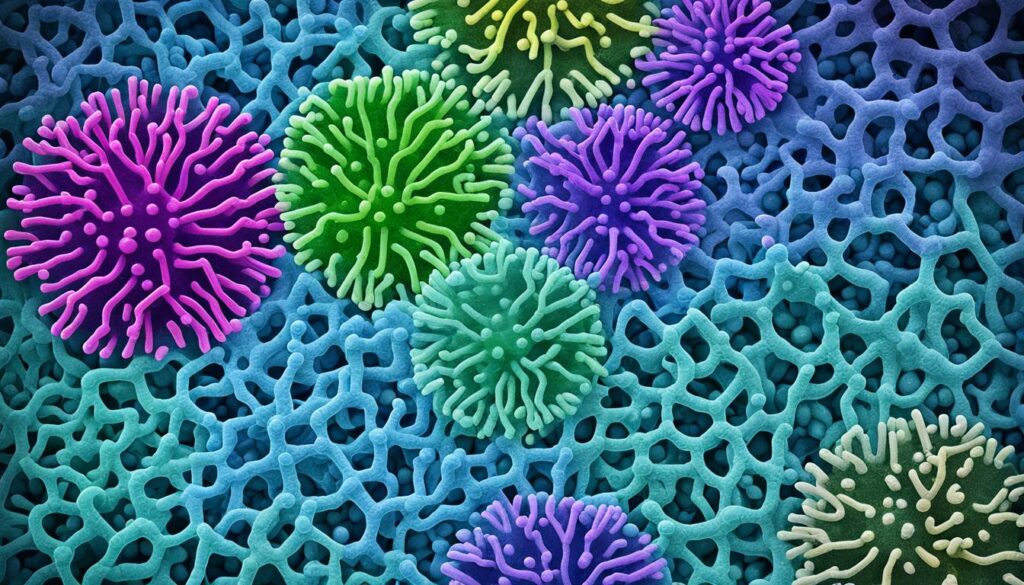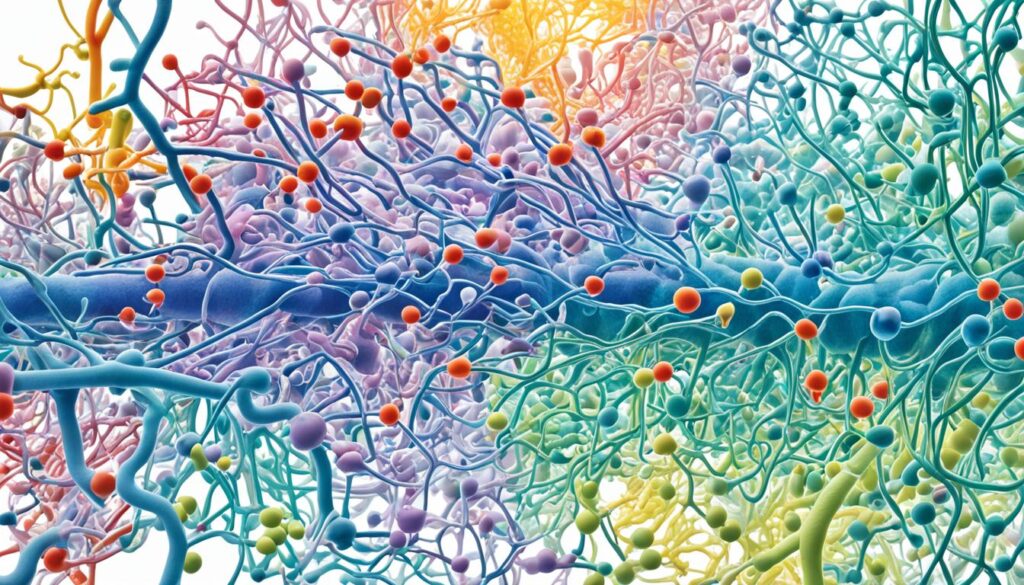Did you know scientists have looked into 170 known bacterial languages? They’re trying to figure out how these tiny life forms talk to each other. Quorum sensing lets bacteria work together by sending chemical signals. This affects how they act in groups. A key player in this is Pseudomonas aeruginosa. It uses a specific modulator, QscR, to control how dangerous it is and how it makes signals. A study by Chugani et al. (2001) showed the importance of QscR. It’s been talked about in 98 articles.
This research helps us see how bacteria talk affects many things. It influences biofilm formation, sickness-causing behaviors, and even how they fight antibiotics. Understanding these conversations can change how we deal with bacteria, keeping us healthier.
Key Takeaways
- Quorum sensing is a method of bacterial communication that relies on signaling molecules.
- Pseudomonas aeruginosa plays a significant role in studying quorum sensing and pathogenicity.
- Cell-to-cell communication is essential for expressing virulence genes in bacteria.
- Research highlights the potential for targeting quorum sensing to combat antibiotic resistance.
- Machine learning is being utilized to categorize bacterial languages and enhance understanding of microbial interactions.
Introduction to Quorum Sensing
Quorum sensing is an amazing way bacteria talk to each other. They use bacterial signaling to know how many of them are around. This microbial communication helps them work together to survive in different places.
As more bacteria gather, they send out more signal molecules called autoinducers. These signals let them know about their environment. They help control important actions like forming biofilms and glowing.
In bacteria, this smart system uses autoinducers to turn genes on or off. For example, Pseudomonas aeruginosa, a type of bacteria, uses molecules called AHLs. But, other bacteria use peptides called AIPs.
Quorum sensing is important not just for bacteria but also for fungi and others. For example, Candida albicans uses substances like farnesol for signaling. This shows how working together is key in microbial communication.
This complex system helps with many tasks, from making antibiotics to forming spores. By learning about it, we can better understand bacteria. This understanding is vital for health care and the environment.
| Microbial Type | Signaling Molecule Type | Key Functions |
|---|---|---|
| Gram-Negative Bacteria | N-acyl-homoserine lactones (AHLs) | Biofilm formation, virulence factor secretion |
| Gram-Positive Bacteria | Autoinducing peptides (AIPs) | Pathogenicity, group behaviors |
| Fungi | Aromatic alcohols (e.g., farnesol) | Pathogenesis, biofilm development |
Understanding the Mechanism of Bacterial Communication
mechanisms of bacterial communication are key for their survival and change. Bacteria use signaling molecules called autoinducers. They check their population size and work together. This teamwork helps bacteria act as one to changes, boosting survival odds.
When signaling molecules hit a certain level, bacteria start to respond. They make things like virulence factors and biofilms. Biofilms make treating with antibiotics tough. Studies show biofilms can be up to 95% resistant, challenging treatment efforts.
Studying bacterial interaction unlocks new research areas. Bacteria like Vibrio cholerae and Staphylococcus aureus depend on strong communication to do well. Tests under real-life conditions have shown fluid movements can mess with quorum sensing, changing how bacteria act.
Here’s a brief look at bacterial communication mechanisms and what they mean:
| Aspect | Description | Implications |
|---|---|---|
| Signaling Molecules | Autoinducers that signal population density | Enables coordinated responses and collective behavior |
| Biofilm Formation | Bacteria aggregate and form protective layers | Increases resistance to antibiotics and host defenses |
| Virulence Factors | Production triggered by high cell density | Enhances pathogenicity and infection potential |
| Inter-Species Communication | Mechanisms like AI-1 and AI-2 allow different species to communicate | Facilitates competition and symbiosis among microbial communities |

Overall, diving into the world of bacterial communication shows us how vital signaling molecules are. They shape bacteria’s ways of interacting, surviving, and thriving in all sorts of places.
Key Players in Quorum Sensing
Quorum sensing is how bacteria talk and act together. It relies on signals and proteins. These help bacteria work as a team.
N-acyl homoserine lactones
N-acyl homoserine lactones (AHLs) are crucial for Gram-negative bacteria’s chat. They become more important as bacteria grow. This increase triggers changes, allowing bacteria to adapt.
AHLs help bacteria send unique messages. This way, they react well to their environment.
Quorum-sensing regulators
Quorum-sensing regulators control how bacteria sense signals. They play a big role in decision-making. For example, they decide when to turn genes on for survival and growth.
These regulators help us understand bacterial tactics for living and adapting.

| Component | Function | Significance |
|---|---|---|
| N-acyl homoserine lactones | Signaling molecules for cell-to-cell communication | Coordinate behavior based on population density |
| Quorum-sensing regulators | Proteins that modulate responses to signaling molecules | Determine gene expression and community behavior |
The Role of Quorum Sensing in Bacterial Behavior
Bacteria talk to each other using quorum sensing. This process helps them act together, based on how many there are. It’s key for their survival, helping them adapt to new environments and interact with other microbes.
Quorum sensing is vital in biofilms too. Here, bacteria use signals to work as a team, improving their chances of survival. By sticking together on surfaces, they form biofilms. These act as shields. Quorum sensing promotes teamwork, sharing, and even competition among different types of bacteria.
This system also controls how harmful bacteria attack. For example, Pseudomonas aeruginosa becomes more dangerous by turning on certain genes and enzymes. This lets them adjust their attack plans, considering the host’s condition and antibiotics they face. This shows how bacteria’s communications affect illness.
So, learning about quorum sensing sheds light on bacteria’s complex world. This knowledge could help us fight infections better. It could lead to new ways to deal with bacteria that form biofilms, which are often hard to treat.

Impact on Biofilm Formation
Biofilm formation is key for bacterial survival in different places. These communities stick to surfaces and fight off threats well. About 80% of microbial infections happen because of biofilms. In these communities, bacteria work together. This helps them survive tough conditions.
The link with quorum sensing is vital for biofilms to start and stay put. Signaling molecules help bacteria talk to each other. This way, they grow stronger as their numbers increase. In rich environments, these talks result in very tough biofilms.
Pathogenic biofilms are a big problem. They can fight off antibiotics much better than single bacteria can. This makes treating infections hard and expensive. For example, biofilms cause a lot of medical costs. They also lead to serious issues like limb loss in people with diabetes.
Moreover, quorum sensing makes biofilms more resilient. The signaling molecules in these biofilms can be very concentrated. This helps the bacteria community thrive. They get better at finding food and surviving stress.
The mix of nutrient levels, biofilm thickness, and where bacteria are leads to different activities. Bacteria on the top get more food. Those at the bottom don’t get as much because of barriers.

Quorum Sensing and Pathogenicity in Bacteria
Quorum sensing is key in bacterial pathogenicity. It lets pathogens act together based on how many of them are there. This strategy makes bacteria better at starting infections.
Pseudomonas aeruginosa and virulence factors
Pseudomonas aeruginosa shows how quorum sensing makes it more dangerous. It turns on genes that help it avoid the body’s defenses. This leads to more serious infections.
With more bacteria around, they start producing harmful enzymes and toxins. This coordinated attack breaks down the body’s defenses. Studies show this strategy is a big part of how Pseudomonas aeruginosa infects its host.
Opportunistic pathogens and infection mechanisms
Opportunistic pathogens attack when the body’s defenses are down. They use quorum sensing to know when to become more aggressive. This includes bacteria like Pseudomonas aeruginosa, changing their attack based on the situation.
These bacteria get a better chance at causing infections this way. A common problem is pneumonia that happens after using a ventilator. This shows how Pseudomonas aeruginosa adapts and targets weaknesses.

The Importance of Cell Density in Quorum Sensing
Cell density is critical in quorum sensing for bacteria. It triggers vital communication processes among them. When bacteria reach a certain number, they start to communicate using special signals like CSP. This is key for their survival.
Studies show bacteria such as Streptococcus pneumoniae react to CSP for genetic changes. This response depends on how many bacteria there are and the environment. As more bacteria gather, their signals get stronger, helping them adapt together.
Models have shown bacteria may respond to signals at a set time, no matter how many there are initially. This tells us that both the number of bacteria and their surroundings play a role. As more bacteria join, systems in them tweak their reaction to signals, making sure they all act together.
To grasp this is to understand bacterial talk and how critical cell density is in it. This ability to communicate and respond keeps bacteria working well together. It shows the delicate balance they need to survive in various places.

Applications of Quorum Sensing Research
Quorum sensing research touches healthcare and agriculture deeply. By studying how bacteria talk to each other, scientists find ways to tackle big problems. These include fighting antibiotic resistance and improving how we grow food.
Antibiotic resistance and disease management
Learning about quorum sensing helps in the fight against antibiotic resistance. By messing with bacteria’s way of chatting, we can weaken the bad guys. This reduces their power to stick together in biofilms, which are tough to beat.
Biofilms make bacteria super resistant, causing over half of infections. In these biofilms, bacteria can resist antibiotics up to 1000 times more. This fact pushes researchers to look for quorum sensing blockers. These blockers can make existing antibiotics work better.
Scientists are testing new treatments that interrupt bacterial signals. For instance, messing with the signaling in Pseudomonas aeruginosa offers fresh ways to handle diseases.
Biotechnology and environmental impact
Quorum sensing has a big role in biotech and farming. Understanding how microbes work together helps crops grow better. This has been shown with tomatoes, using Effective Microorganisms (EM) technology to boost their growth.
Quorum sensing also affects how we farm sustainably. It guides ways to feed more people with less harm to our planet. By improving how crops are grown, we can lessen environmental damage.

| Application Area | Focus | Impact |
|---|---|---|
| Healthcare | Combatting antibiotic resistance | Improved treatment protocols through quorum sensing inhibitors |
| Biotechnology | Enhancing crop yield | Sustainable agricultural practices to meet global food demands |
| Environmental Science | Understanding microbial interactions | Minimized ecological footprint in crop production |
Future Directions in Quorum Sensing Studies
The future of quorum sensing studies is full of potential for major breakthroughs. Focus on changing microbial talks to create new treatments is vital. These treatments could better fight infections. There was a big jump to 208 publications in 2022, showing more scientists are getting interested.
Since 1998, the US has published 1,743 articles on anti-quorum sensing agents (anti-QSA). This puts it at the forefront worldwide. The interest in this area has gone up a lot. This shows people are looking more into how quorum sensing affects bacterial actions.
- Research is now focusing on making drugs that stop biofilms and harmful bacteria traits.
- New areas being looked into are using nanomaterials, stuff from the ocean, and AI to fight bacteria.
- Studies that mix microbiology, medicine, and nature studies will help understand bacterial talks better.
Keep an eye on the newest research, including work on silver particles and marine fungus. These could be game-changers in fighting against harmful bacteria.

Quorum Sensing: A Double-Edged Sword?
Quorum sensing lets bacteria talk to each other, changing their actions when there are more or fewer of them. It’s like a secret code that has both good and bad sides. For example, some good bacteria help plants grow by improving how they get nitrogen. This is great for crops like peas and lentils.
But, the same process helps bad bacteria become more dangerous. Pseudomonas aeruginosa, a type of harmful bacteria, uses quorum sensing a lot. It controls many genes that make it resistant to antibiotics and help it form protective layers called biofilms. This shows how bacterial communication can be harmful.

Quorum sensing’s two sides make it complicated but very important to understand. It can help plants grow and fight off diseases. However, it also makes some bacteria very tough to beat. Scientists are working to figure out how to use the good parts of this process while stopping the bad ones.
| Aspect | Benefits | Risks |
|---|---|---|
| Bacterial Communication | Enhances cooperation among beneficial bacteria | Facilitates virulence in pathogens |
| Applications | Promotes plant growth (e.g., UD1022) | Contributes to antibiotic resistance (e.g., Pseudomonas aeruginosa) |
| Health Implications | Uses beneficial interactions in agriculture | Potential for increased infections and resistance |
Understanding quorum sensing is key to using it well in health and farming. Finding ways to get its benefits without the downsides is a big challenge for scientists.
Conclusion
Quorum sensing is key in how bacteria communicate. It lets them measure their numbers and change gene expression. This affects many things, like how they act in their environments.
This method can affect up to 10% of a bacterial genome. It’s vital in controlling diseases, especially in bacteria like Pseudomonas aeruginosa.
Research in quorum sensing is very important. It helps us understand how bacteria talk to each other. Through this knowledge, we can fight antibiotic resistance better.
This research can lead to big advances in how we manage diseases. It also might help us in biotechnology, creating safer and cleaner environments.
Learning more about quorum sensing can bring new ways to deal with infections. It can also improve how we use bacteria in science. This knowledge could make a big difference for our health and the planet.










